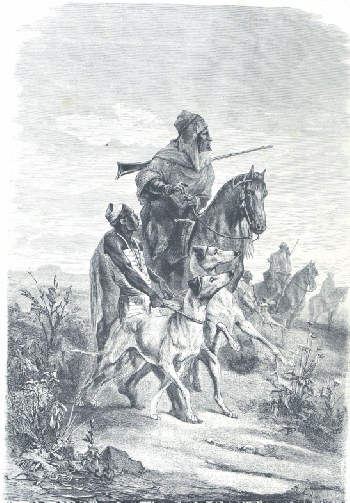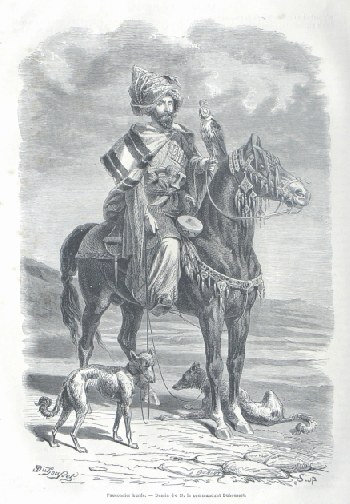
| Sloughi
World
|
|
Forum | Pedigree
Database | Impressum
|

| Sloughi
World
|
|
Forum | Pedigree
Database | Impressum
|
| History
The Sloughi's Stolen History
The first known document to describe in detail the Algerian Sloughi is translated into English to describe the Saluki  Algerian sloughis by A. Lançon "Two hunts with Sighthounds, in France and Algeria" by Vicomte de Dax, in "La Chasse Illustrée" ("The Illustrated Hunt") 1870. © de Caprona, 2009 Général Daumas, in "Les Chevaux du Sahara et les Moeurs du Désert", 1852 This French general became famous during the Algeria campaign of the XIXth century. After studying Arabic, he studied Algerian customs in depth. He became Consul of Mascara with the Emir Abd-el-Kader from 1837-1839. Under the General de Lamoricière, he then became the director of Arab affairs in Oran. Later, the Maréchal Bugeaud nominated him to head the indigenous Affairs of Algeria. In 1850 he became the director of Algerian Affairs at the Ministry of War. Title of the
chapter “ Le lévrier seul a l’estime, la considération, la tendresse attentive de son maitre; c’est que le riche, ainsi que le pauvre, le regardent comme un compagnon de leurs plaisirs chevaleresques auxquels ils se plaisent tant; pour ce dernier, c’est aussi le pourvoyeur qui le fait vivre” “ Le lévrier est intelligent et plein d’amour propre....La vanité ne lui fait pas défaut, “il fait beaucoup de fantasia”. Un sloughi de race ne mange ni ne boit dans un vase sale, il refuse le lait dans lequel on a plongé les mains. Ne lui a-t-on pas donné cette délicatesse dédaigneuse? Tandis que c’est tout au plus si on laisse le chien vulgaire, utile et vigilant gardien, chercher sa nourriture parmi les charognes et les os gisants; tandis qu’on l’expulse honteusement loin de la tente et de la table, le lévrier, lui, couche dans le compartiment réservé aux hommes, sur des tapis, à côté de son maitre ou sur son lit même. Il est vêtu, garanti du froid par des couvertures, comme le cheval, on lui sait bon gré d’être frileux, c’est une preuve de plus qu’il est de race. On prend plaisir à le parer d’ornements, à lui attacher des colliers de coquillages; on le garantit du mauvais œil en lui mettant des talismans. On le nourrit avec soin, avec recherche, avec précaution aussi, le kouskoussou lui est prodigué. En été, pour lui donner de la force, on lui fait une pâtée de lait et de dates, dont on a ôté les noyaux”. “ Le lévrier accompagne son maitre dans ses visites; comme lui il reçoit l’hospitalité (difa), et de chaque mets il a sa part. Jamais un sloughi ne chasse qu’avec son maitre. Il sait, par sa propreté, son respect des convenances et la gracieuseté de ses manières, reconnaitre la considération dont il est l’objet...” “ Le sloughi
du Sahara
est de beaucoup supérieur à celui du Tell; il est de
couleur
fauve, haut de taille, il a le museau effilé, le front large,
les
oreilles courtes, le cou musculeux, les muscles de la croupe
très
pronouncés, pas de ventre, les membres secs, les tendons bien
détachés,
le jarret près de terre, la face plantaire peu
développée,
sèche, les rayons supérieurs très longs, le palais
et la langue noirs, les poils très doux. Entre les deux
iléons,
il doit y avoir place pour quatre doigts, il faut que le bout de la
queue
passée sous la cuisse atteigne l’os de la hanche.  Persian Sighthounds with Kurdish Falconer, "Hunting in Persia" in "Le Tour du Monde" 1860 Texte and illustrations by Commandant E. Duhousset. The Persian Sighthound is now named "Saluki" © de Caprona, 2009 “The Ways of the Desert” by Sheila M. Ohlendorf, 1973 University of Texas Press, Austin & London Title of the
chapter In this chapter the words "Lévrier" (Sighthound) and "Sloughi" (here Algerian Sighthound) are systematically replaced by "Saluki" “ Only the saluki has the esteem, the consideration, the watchful tenderness of his master. That is because the rich, as well as the poor, regard him as a companion of their chivalresque pastimes in which they take such pleasure. For the poor, the saluki is also the purveyor who keeps them alive” “ The saluki is intelligent and full of self esteem…..Vanity is not lacking in him. “He makes a great deal of fantasia “[show]. A purebred saluki neither eats nor drinks from a dirty vessel, he refuses milk in which someone has plunged his hands. Has he not been trained for delicate disdain? Whereas the common dog, useful and vigilant guardian, is at the most allowed to seek his food among carrion and old bones, whereas he is shamefully repulsed far from the tent and the table, the saluki, he, himself, lies in the room reserved for the men, on the carpets at his master’s side or even on his bed. He is clothed, protected from the cold with blankets, like the horse; it is well known that he is very sensitive to the cold. It is one more proof of his being purebred. Pleasure is taken in adorning him, in putting shell collars on him. He is protected against the evil eye by the talismans put on him. He is fed carefully, with concern, also with precaution. Couscous is given to him liberally. In summer to give him strength a “pâtée”, made of milk and dates with their pits removed, is made for him.” “ The saluki accompanies his master on his visits; like him he is given hospitality (difa) and has his share of each dish. A purebred saluki never hunts but with his master. He knows, by his cleanliness, his respect of conventions, and the graciousness of his manners, how to acknowledge the consideration of which he is the object…” “ The saluki
of the
Sahara is much superior to that of the Tell. He is of a tawny color,
tall,
with a long narrow muzzle, wide forehead, short ears, muscular neck,
very
pronounced haunch muscles, no belly, clean legs, tendons prominent,
hocks
close to the ground, sole little developed, dry, the upper forelegs
very
long, the palate and tongue black, the hair very soft. Between the two
ilia there should be room for four fingers; it is necessary that the
tip
of the tail, brought under the thigh, reach the bone of the
haunch. Note: the previous English translation by J. Hutton (1863), seems to have replaced the word "Sloughi" by "Saluki" as well, although the term "lévrier" was correctly translated into "greyhound", if one should trust two quotes in "The Saluki in History, Art and Sport" by Hope and David Waters (1969). Page 37 Quote: "The greyhound sleeps in the compartment reserved for men", it was recorded of North African Salukis in the early nineteenth century, "on carpets by his master's side, or on his very bed. He is clothed and sheltered from the cold, like the horse, and is even preferred for being chilly, as that is additional proof of the purity of his race (E. Daumas, The Horses of the Sahara and the Manners of the Desert, 1863)" Page 101: Quote: "The general's sixteen years' experience of the Sahara dated from 1837. He described the Saluki's characteristics and the enthusiasm for and respect of 'the people of the Sahara' for their 'greyhounds'." |